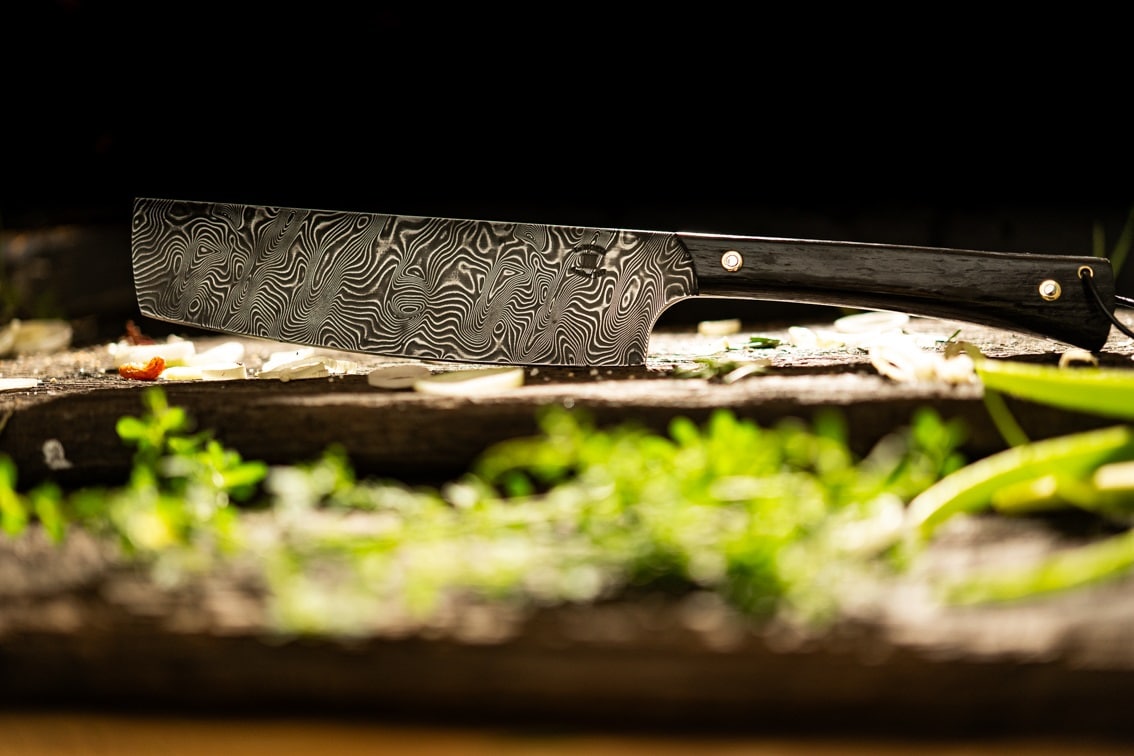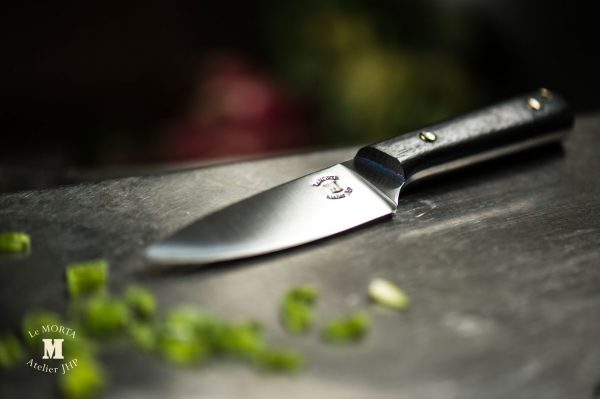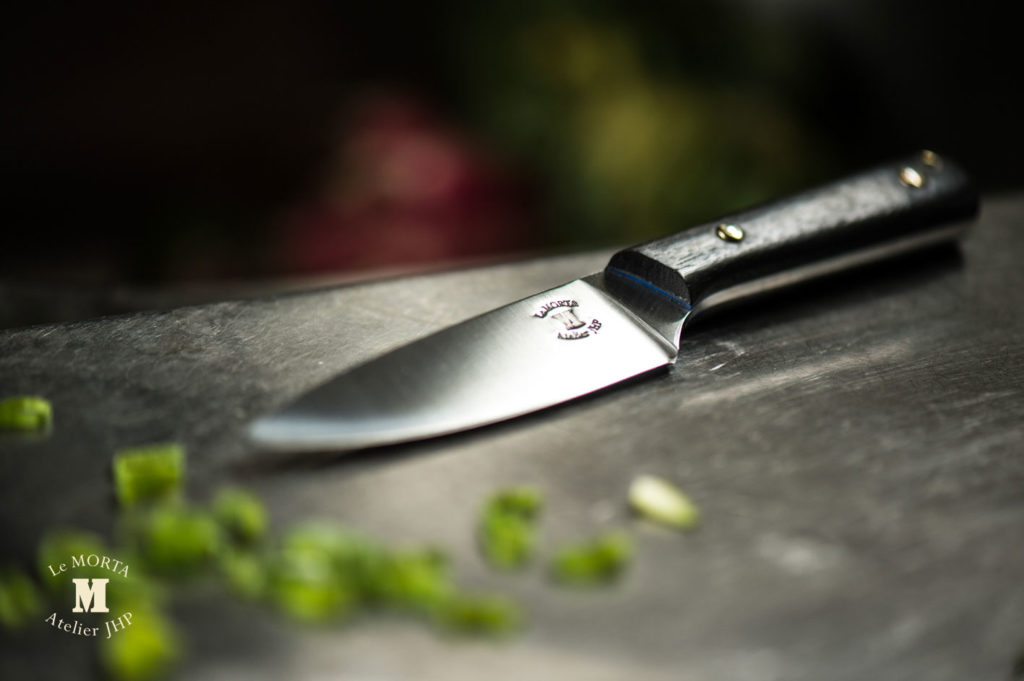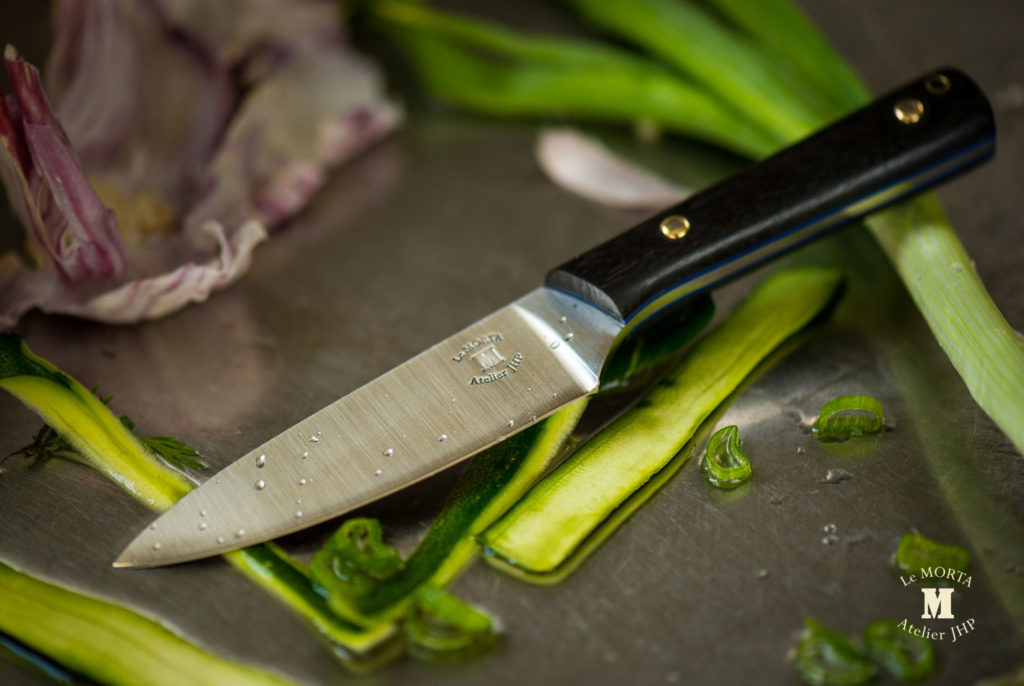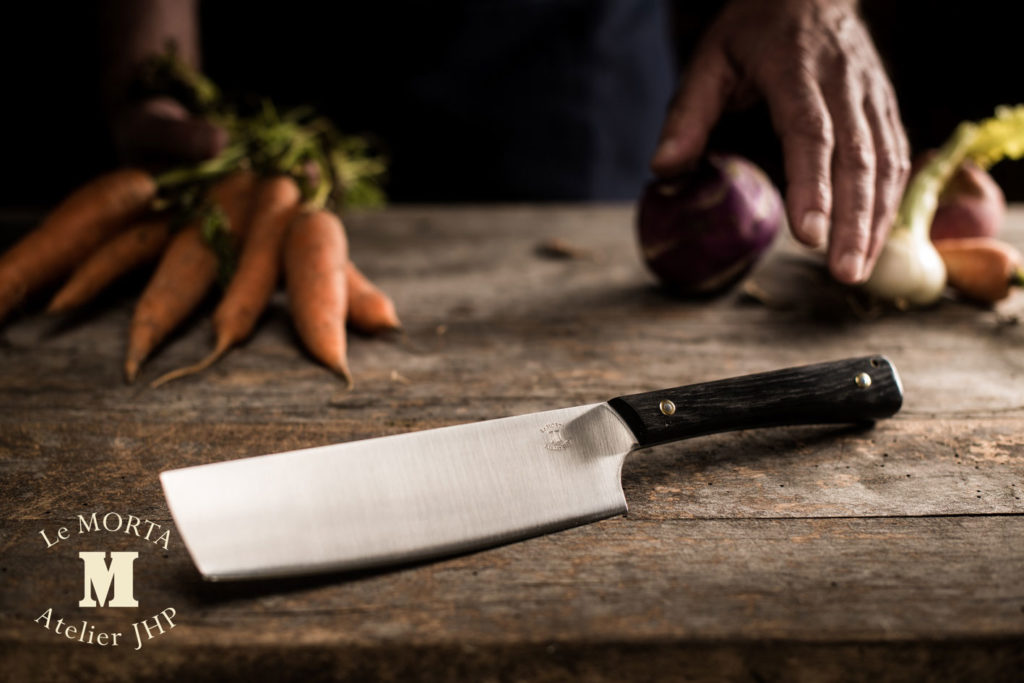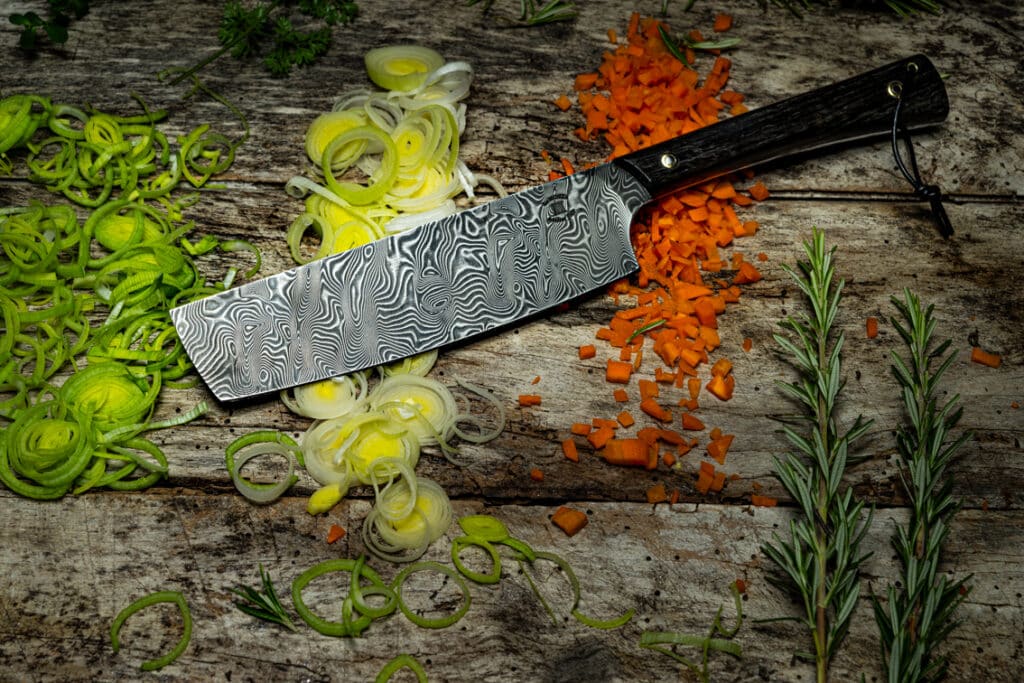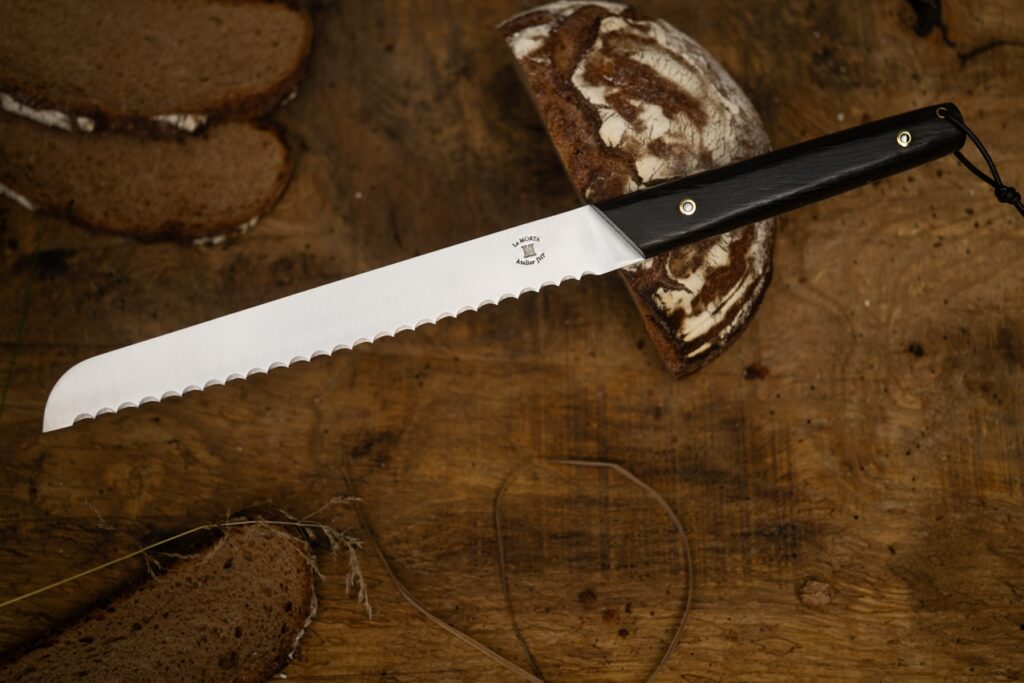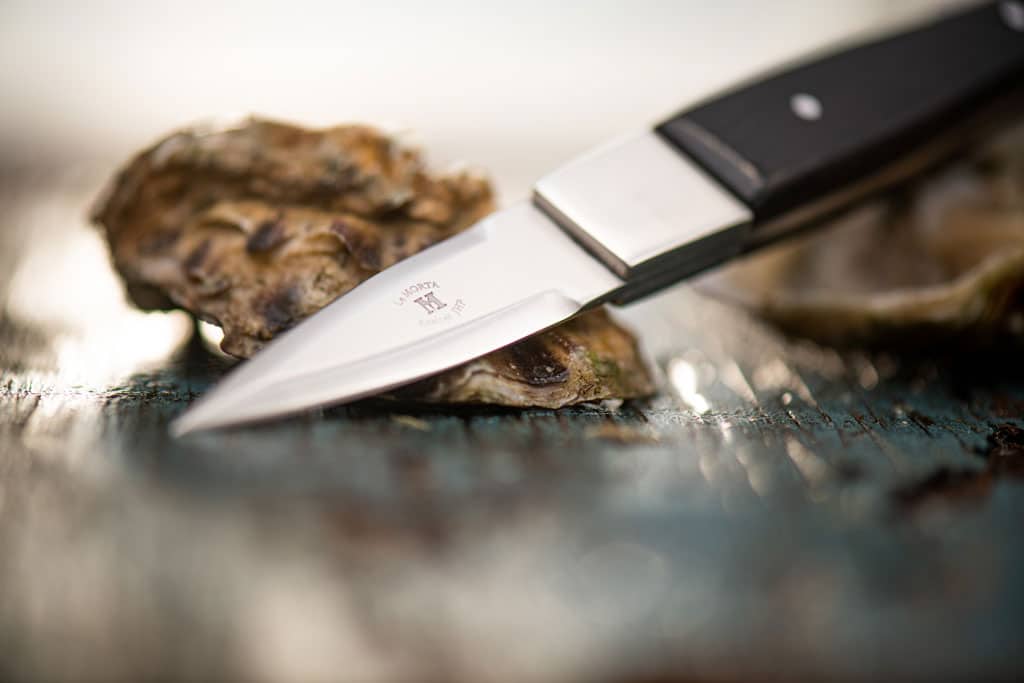What is the best kitchen knife: how to respond with complete objectivity? The quality of the edge, the resistance of the blade, and ergonomics are all undeniable criteria in cutlery. However, some great chefs insist that the finest steel is called Damascus, while others, with more rustic tastes, prefer raw forge. Still others swear only by stainless steel. This article guides you between paring knife and chef’s knife. It also advises you on how to better follow your instinct and satisfy the future owner of the knife you have chosen. Because beyond all cutlery and culinary techniques, there remains the indescribable pleasure of cutting with an artisanal knife.
The chef’s knife: A must-have for cooks
Cut cleanly, without burrs, quickly and safely: this is the primary mission of a chef’s knife. Its blade is thick. It measures between 16 and 36 cm. Its length is around 20 cm depending on the brand, which allows for cutting ingredients of various sizes. Finally, the height of the blade varies between 4 and 5 cm. The blade edge is smooth.
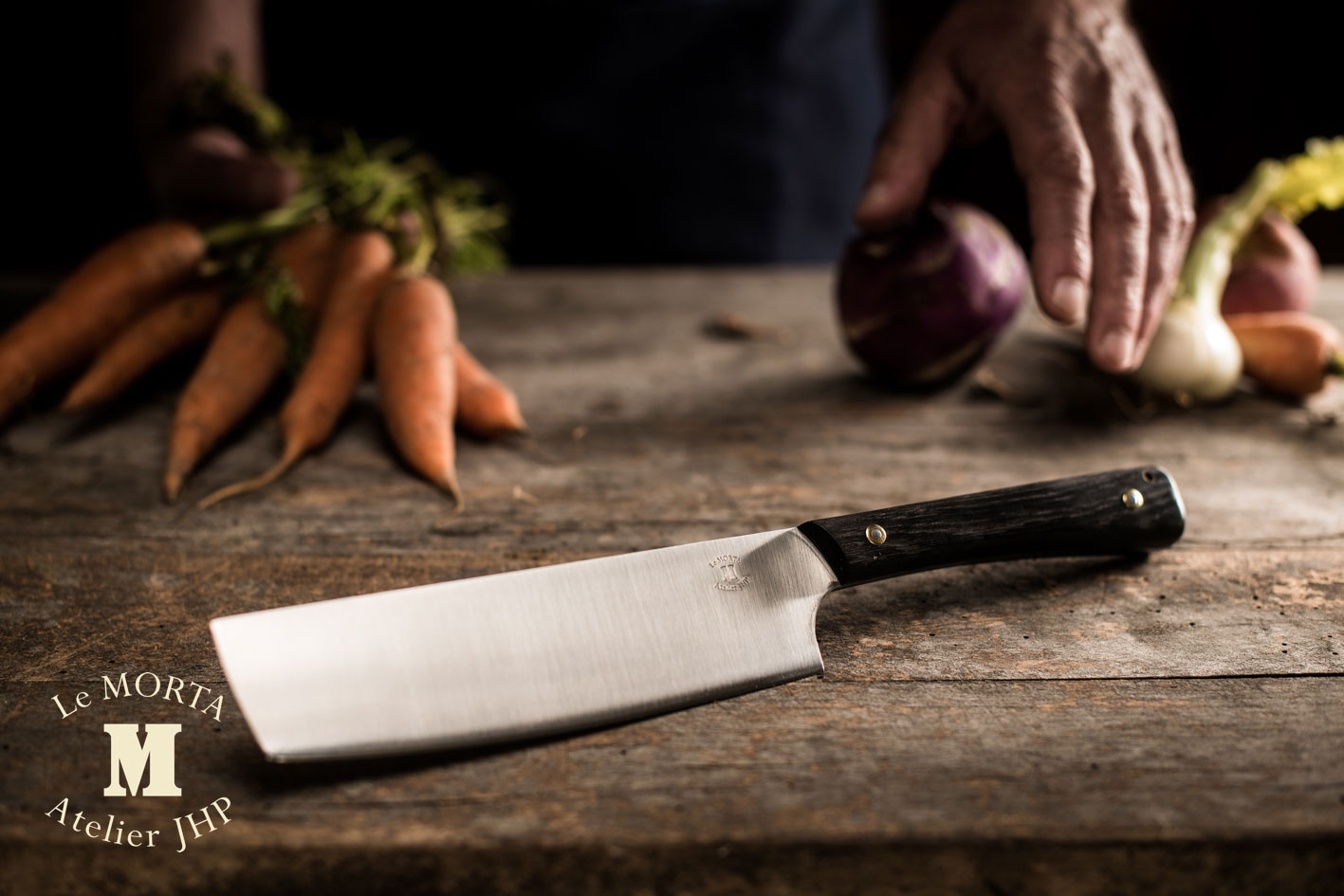
The exact shape of the blade differs depending on the manufacturers. At Morta Knives, we designed the blade based on the advice of Chef Eric Guérin, who likes to use the truncated tip to reserve freshly cut food.
These blade dimensions make the chef’s knife safer, as the finger has plenty of space to rest against the blade and not slip.
The advantage of the chef’s knife is the swinging motion that the high blade allows. It gives a balanced and regular gesture to perfectly mince without danger, ideal for garlic, parsley, onions, or shallots.
A versatile knife, it cuts all foods: meat, fish, vegetables, fresh herbs, and fruits. It chisels, minces, slices, and chops.
🔪 The chef’s knife can replace a bread knife. Nevertheless, the serrated blade remains significantly more suitable for cutting a nice crusty crust.
😉 Did you know?
Éric Guérin, a starred chef, cooks with Morta knives. Check for yourself at La mare aux oiseaux, a gourmet restaurant in Saint-Joachim (44).
The paring knife: The kitchen must-have
Smaller than the chef’s knife, the paring knife is the indispensable must-have in your kitchen.
Its blade is thin, semi-pointed, and slightly tapered. It measures between 7 and 11 cm. Its edge is smooth. We like it light and manageable.
It too has a versatile function and cuts both meat and fish; it slices and peels vegetables. It finely chops condiments. It cuts into cubes or strips depending on whether you want cheese cubes for aperitifs or thinly sliced vegetables for your julienne.
Amateur cooks use it particularly to trim fruits and remove seeds. It is also very handy for removing parts of meat such as fat, nerves, or skin. It offers a perfect alternative to various butcher knives.
The paring knife also serves as a table knife. Who knows, maybe it’s the first of a long collection?
Discover our Morta knife collection
If your knife drawer isn’t very full, the paring knife easily replaces:
🔪 the steak knife;
🔪 the dough cutter (pizza cutter to be clearer);
🔪 the fish filleting knife: mackerel, sea bream, sole. For larger fish such as salmon or tuna, you’ll still be more comfortable with a chef’s knife or an XL paring knife.
How to choose the best kitchen knife: Important criteria
Aesthetics for your knife
Many criteria come into play when choosing your best kitchen knife. However, at Morta Knives, we remain very attached to the emotional dimension of the knife. Yes, we detail below the characteristics to study. But, don’t forget that the best knife remains the one you like to hold between your fingers.
Perhaps the best for you is simply the one your grandfather bequeathed to you, even if it is old and worn.
A kitchen knife, no matter how effective it is, must above all please you.
Keeping a place for aesthetics in your decision is preserving that little extra, that slight tug at the heart when you grab it and start cooking. A good workman always has the right tools. Certainly, but if he finds them ugly 😉, he will struggle to get to work.
An artisanal knife carries a story and reveals itself when you’re the one holding it. At Morta Knives, all our handles are made from this unique, local, and noble wood: morta. Lovers of beautiful things and rustic and authentic design will appreciate our collections.
To accentuate its beauty, consider personalizing it: mini mammoth ivory inlays, vulcanized blue fiber, engraving, etc. A small original note for even more character.
Our best tips for personalizing a knife
Blade steel for a perfect edge
Cutlers always offer various steel variants. High carbon steels offer good durability. Stainless steels are perfect against corrosion.
Rest assured, all are suitable for a beautiful quality blade. Their characteristics differ, but it would be too sharp to define a better steel. Between 14c28n, character tempered steels like forged steel 90mcv8 or the incomparable Damascus, choose especially according to the sensation it gives you at sight and touch.
What do you prefer? Or what does the person you are about to offer a knife to like?
A raw and authentic metal 🔪 Go for raw forged blades
A beautiful blade 🔪 Dare the Damascus steel
A blade implacable against corrosion 🔪 Go for stainless steel.
The hardness of the steel also plays a crucial role in choosing a knife. Check that it’s at a minimum of 59 HRC on the Rockwell scale.
Know that the frequency of sharpening varies from one steel to another, but the difference is minimal enough not to worry about it when purchasing.
Ergonomics for ideal cutting comfort
Ergonomics, of course, is essential. It makes the knife practical, precise, pleasant, comfortable, and safe. If you buy your knife from a quality cutlery shop, don’t worry about its ergonomics. It’s a basic element studied from the first stages of designing a model.
Think about the weight of the knife according to its future owner. The first folding knife of a budding gastronome will be lighter than the knife you offer for the retirement of a starred chef.
Versatility for everyday cooking
If you’re buying your first knife, then it’s probably better to bet on its versatility. Choose a model that will serve you most often.
🔪 a folding knife follows you everywhere;
🔪 a medium-sized knife cuts most foods and isn’t too bulky;
🔪 a stainless blade cleans easily.
Cartesian thinking would therefore deduce that the best kitchen knife is the massive folding Morta in Sandvik steel. There again, this would be presuming on your subjectivity and tastes.
The different types of kitchen knives
To determine the best knife for your kitchen, here’s a panel of all the knives used in gastronomy.
🔪 Meat knives for skinning, deboning, bleeding, filleting, trimming, slicing.
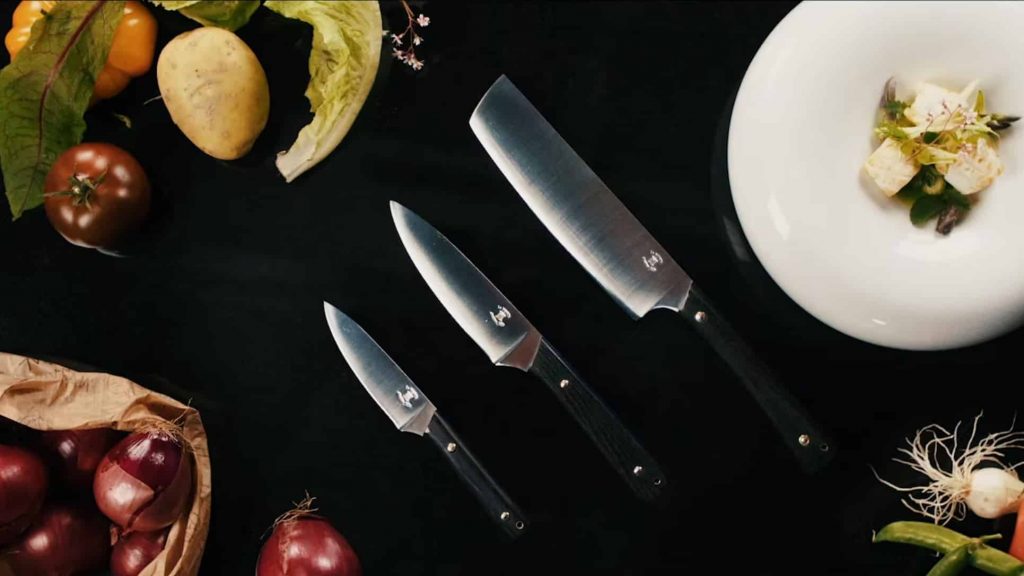
🔪 Fish filleting knives (different from fish table knives or oyster knives).
🔪 Cheese knives: either wide and rectangular, or with a raised pointed end.
🔪 Vegetable knives (in bird’s beak).
🔪 Japanese knives (Nakiri, Kiritsuke, Sujihiki, Bunka, Deba, Sushi, Gyutoh, Shotoh, Pankiri).
🔪 Bread knives.
🔪 Spreading knives.
These categories are useful if you have a wide range of knives in your kitchen. The majority of households use the paring knife and the chef’s knife to fulfill the different functions presented above. The more specific the knife, the fewer culinary tasks it accomplishes.
Maintaining your Morta kitchen knife
Why prefer an artisanal kitchen knife?
Buying an artisanal object is, above all, a choice of values. Industrial production abundantly supplies average quality knives. It mainly uses standard materials to minimize costs. No judgment, the budget is sometimes incompressible.
But, there are knives and there are knives. The one that lies in the drawer and that you lose at the first move, and the one that, all your life, remains YOUR knife.
Buy a French knife
Choosing your kitchen knife in a traditional cutlery shop ensures you’re buying French. At Morta Knives, all our suppliers reside in France. Only our metal mugs come from the Czech Republic, as the French market doesn’t offer them. Our neck tours, natural sharpening stones, belts, cases, sheaths, and storage pouches are of French manufacture.
We sell to both visitors, curious to discover our craft, and on our online shop. The health crisis reminded us of the importance of local purchases.
Support passionate artisans
Supporting craftsmanship is also encouraging younger generations to perpetuate professions where passion reigns. Making a knife requires imagination, rigor, technique, precision, patience, and also a lot of love. The choice of materials, the care given to them, the transmission of know-how, all constraints reduced by the flame of cutlery.
An artisanal knife is also a knife prized for its durability.
Acquire a noble material
Most artisans start with a material (glass, stone, etc.). For us, it’s wood. Morta, this unique wood, 5 millennia old, from the peat of Brière. We extract it ourselves with the strength of our arms to transform it into a knife handle.
Governed by a convention signed with the Synodic Commission of the Grande Brière Mottière, the Brière Regional Natural Park, and supported by biodiversity services, the extraction of morta is strictly regulated. Working with Morta may be an art. For us, it’s above all an honor.
For you, owning a Morta knife means carrying 5,000 years of history in your pocket. In this case, in your kitchen, but you get the spirit 😉.
And if you like walks and picnics in the forest, imagine yourself, in the middle of nature, cutting a sausage with a knife of ancestral wood. Not bad, right?
Defining the best kitchen knife goes beyond the shape of the blade or the choice of steel. Sharpness and ergonomics are essential. But nothing replaces the absolute pleasure of feeling the patina of the wood in the palm of your hand when you’re about to cook. The kitchen knife cuts, slices, and peels. The kitchen knife is also the utensil that makes you want to cook or not 😉.
Key questions from the article
What is the best kitchen knife for daily use?
The best kitchen knife is first and foremost the one that suits your needs and your way of cooking. If you’re looking for a versatile tool, the chef’s knife is essential.
It allows you to slice meats, fish, vegetables, and herbs with precision.
Its smooth blade and shape offer an ideal swinging motion for a clean and precise cut.
Why is the paring knife ideal for everyday cooking?
The paring knife is a compact and manageable model, perfect for meticulous preparations. Its smooth blade of 7 to 11 cm is ideal for mincing condiments, peeling vegetables, or slicing small pieces of meat.
What are the criteria for choosing the best kitchen knife?
To find the ideal knife, you must take into account:
- The blade steel: stainless steel knives are resistant to corrosion, while forged and Damascus knives offer great durability.
- Ergonomics: a high-quality knife must offer a comfortable grip to ensure precise movements.
- Versatility: some models like the 20 cm chef’s knife are suitable for cutting all meats and other foods.
- Aesthetics: a beautiful knife adds pleasure to meal preparation.
What are the different types of essential kitchen knives?
- Chef’s knife: the most versatile, perfect for mincing, chiseling, and slicing.
- Paring knife: ideal for small cuts and peeling.
- Bread knife: designed with a serrated blade for a clean cut of the crust.
- Boning knife: specially designed to remove meat from bones with precision.
How to maintain your steel knives for a long lifespan?
Your kitchen knives require proper maintenance.
- Sharpen them regularly with a steel or a sharpening stone.
- Morta spent 5000 years in a humid environment; let’s respect its need for a dry environment.
- Store your kitchen knives in a knife block or a case to protect the edge.
Why choose an artisanal kitchen knife rather than an industrial model?
As artisans, we design high-quality knives, designed for durability and aesthetics. Each knife is made in a traditional way, has an identity, and guarantees a better grip.
It’s the ideal choice for lovers of beautiful knives and authentic knife making.
How to choose an effective bread knife?
A good bread knife must have:
- pronounced serrations for an impeccable cut.
- a comfortable handle for better maneuverability.


